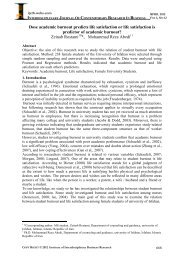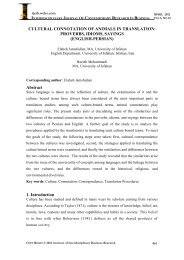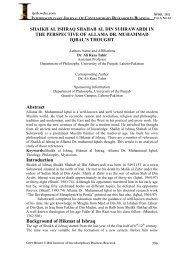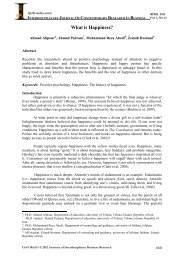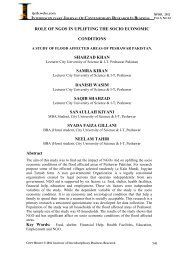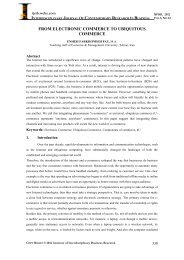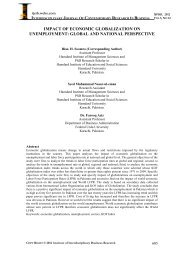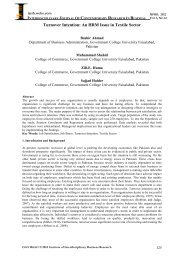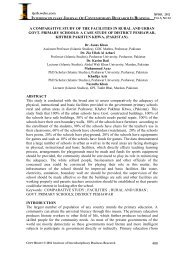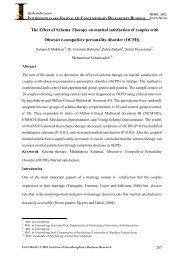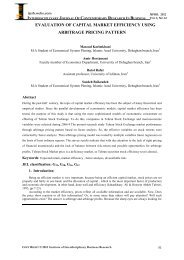The effects of informal groups on organizational - journal ...
The effects of informal groups on organizational - journal ...
The effects of informal groups on organizational - journal ...
You also want an ePaper? Increase the reach of your titles
YUMPU automatically turns print PDFs into web optimized ePapers that Google loves.
ijcrb.webs.comINTERDISCIPLINARY JOURNAL OF CONTEMPORARY RESEARCH IN BUSINESSAPRIL 2012VOL 3, NO 122. Literature review:2.1. Informal group and organizati<strong>on</strong>al performance:Blau and Scott (1962) declared that employees usually do not accomplish their duties byall <str<strong>on</strong>g>of</str<strong>on</strong>g> their power because formal authority <str<strong>on</strong>g>of</str<strong>on</strong>g>ten cannot motivate employeescompletely. Additi<strong>on</strong>ally, formal authority has forced employees to show certainbehaviors standardized by regulati<strong>on</strong>s so they c<strong>on</strong>tract their efforts and avoid beinginnovative and creative. On the other hand, <str<strong>on</strong>g>informal</str<strong>on</strong>g> organizati<strong>on</strong>s are the interlockingsocial structure created to answer employees’ social and psychological needs becausepeople need to feel they are part <str<strong>on</strong>g>of</str<strong>on</strong>g> something.Organizati<strong>on</strong>al sociologists count several reas<strong>on</strong>s why <str<strong>on</strong>g>informal</str<strong>on</strong>g> <str<strong>on</strong>g>groups</str<strong>on</strong>g> form. M<strong>on</strong>geand Eisenberg (1987) discussed <str<strong>on</strong>g>informal</str<strong>on</strong>g> <str<strong>on</strong>g>groups</str<strong>on</strong>g> pop out when people try to express<str<strong>on</strong>g>effects</str<strong>on</strong>g>, influence attempt, and exchange informati<strong>on</strong> or services. Some researchers haveidentified some psychological reas<strong>on</strong>s for the existence <str<strong>on</strong>g>of</str<strong>on</strong>g> <str<strong>on</strong>g>informal</str<strong>on</strong>g> networks such asaffiliati<strong>on</strong> needs, the sense <str<strong>on</strong>g>of</str<strong>on</strong>g> identity, social reality, and defense mechanism (Baker,1981; Han, 1983). Waldstrom (2001) have classified the reas<strong>on</strong>s why employees engagein <str<strong>on</strong>g>informal</str<strong>on</strong>g> <str<strong>on</strong>g>groups</str<strong>on</strong>g> into three categories: (1) technical reas<strong>on</strong>s related to work issues, (2)political reas<strong>on</strong>s related to individual and group goals, and (3) cultural approaches. Inadditi<strong>on</strong>, Crampt<strong>on</strong> and Hodge (1998) indicated that <str<strong>on</strong>g>informal</str<strong>on</strong>g> structures can satisfy theneed <str<strong>on</strong>g>of</str<strong>on</strong>g> knowing by their faster and less cumbersome communicati<strong>on</strong> network. Someothers stated that people seek benefits so individuals might join an <str<strong>on</strong>g>informal</str<strong>on</strong>g> group to useits power to bias colleagues or superiors in order to obtain an advantage (Waldstrom,2001).Overriding factor that creates an <str<strong>on</strong>g>informal</str<strong>on</strong>g> group is friendship or comm<strong>on</strong> interest butthe role <str<strong>on</strong>g>of</str<strong>on</strong>g> members is not the same into an <str<strong>on</strong>g>informal</str<strong>on</strong>g> network. Stephens<strong>on</strong> (1998)categorized three kinds <str<strong>on</strong>g>of</str<strong>on</strong>g> roles in <str<strong>on</strong>g>groups</str<strong>on</strong>g> by focusing <strong>on</strong> the flow <str<strong>on</strong>g>of</str<strong>on</strong>g> informati<strong>on</strong> in thegroup: (1) Hubs; people who are most c<strong>on</strong>nected with others, (2) Gatekeepers; transportinformati<strong>on</strong> between hubs, and (3) Pulse takers; they influence how other membersperceive the informati<strong>on</strong>. Moreover, she believes that <str<strong>on</strong>g>informal</str<strong>on</strong>g> networks are the initialstage <str<strong>on</strong>g>of</str<strong>on</strong>g> organizati<strong>on</strong>al structure and have hierarchical development which set its ownorganizing principles. This kind <str<strong>on</strong>g>of</str<strong>on</strong>g> classificati<strong>on</strong> and argument dem<strong>on</strong>strate that theimportance and effect <str<strong>on</strong>g>of</str<strong>on</strong>g> members are different so the c<strong>on</strong>cept <str<strong>on</strong>g>of</str<strong>on</strong>g> <str<strong>on</strong>g>informal</str<strong>on</strong>g> leaders wascreated. Although, Informal leaders have not legislative power <str<strong>on</strong>g>of</str<strong>on</strong>g> hiring and firingemployees, they are followed by members because <str<strong>on</strong>g>of</str<strong>on</strong>g> their inspiring and moral <str<strong>on</strong>g>effects</str<strong>on</strong>g>.Some studies reveal that <str<strong>on</strong>g>informal</str<strong>on</strong>g> leaders have a str<strong>on</strong>g influence <strong>on</strong> group operati<strong>on</strong>sand outcomes (Pescosolido, 2001) so it is not questi<strong>on</strong>able to c<strong>on</strong>sider them as a source<str<strong>on</strong>g>of</str<strong>on</strong>g> power beside formal authority. <str<strong>on</strong>g>The</str<strong>on</strong>g>refore, there are c<strong>on</strong>troversy surroundingswhether <str<strong>on</strong>g>informal</str<strong>on</strong>g> <str<strong>on</strong>g>groups</str<strong>on</strong>g> are positive entities in organizati<strong>on</strong>s.<str<strong>on</strong>g>The</str<strong>on</strong>g>re is a plethora <str<strong>on</strong>g>of</str<strong>on</strong>g> debates dem<strong>on</strong>strating <str<strong>on</strong>g>groups</str<strong>on</strong>g> have a str<strong>on</strong>g effect <strong>on</strong>organizati<strong>on</strong>al effectiveness by influencing <strong>on</strong> both employees and superiors’ functi<strong>on</strong>s.First <str<strong>on</strong>g>of</str<strong>on</strong>g> all, according to the social identity theory, employees would be satisfied by thesense <str<strong>on</strong>g>of</str<strong>on</strong>g> bel<strong>on</strong>ging which stimulates the process <str<strong>on</strong>g>of</str<strong>on</strong>g> motivati<strong>on</strong> and improve self-esteem,resulting in high level <str<strong>on</strong>g>of</str<strong>on</strong>g> performance (Gary, 1996; Smith, 2008). Sec<strong>on</strong>dly, formalcommunicati<strong>on</strong> arranged by management are likely unidirecti<strong>on</strong>al and underprivilegedwhile <str<strong>on</strong>g>informal</str<strong>on</strong>g> <str<strong>on</strong>g>groups</str<strong>on</strong>g> use <str<strong>on</strong>g>informal</str<strong>on</strong>g> communicati<strong>on</strong> net that is sp<strong>on</strong>taneous, interactive, andmore effective because <str<strong>on</strong>g>of</str<strong>on</strong>g> the lack <str<strong>on</strong>g>of</str<strong>on</strong>g> pre-specificati<strong>on</strong> (Ouchi, 1980; Kraut et al, 2002).Sp<strong>on</strong>taneously, group awareness increases when the sharing <str<strong>on</strong>g>of</str<strong>on</strong>g> informati<strong>on</strong> increases soCOPY RIGHT © 2012 Institute <str<strong>on</strong>g>of</str<strong>on</strong>g> Interdisciplinary Business Research 366



